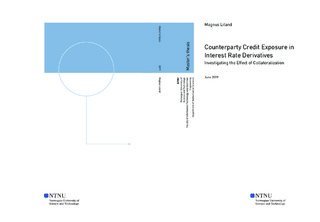| dc.contributor.advisor | Laading, Jacob | |
| dc.contributor.author | Liland, Magnus | |
| dc.date.accessioned | 2019-10-26T14:00:43Z | |
| dc.date.available | 2019-10-26T14:00:43Z | |
| dc.date.issued | 2019 | |
| dc.identifier.uri | http://hdl.handle.net/11250/2624615 | |
| dc.description.abstract | Denne rapporten omhandler bruken av en stokastisk rentemodell, basert på LIBOR market models (LMM), til å bestemme prisen til rentederivater, samt risikoen assosiert ved derivatene. Etter å ha etablert grunnleggende konsept relatert til finans og risikostyring, blir funksjonaliteten til rentemodellen undersøkt ved inspeksjon av de genererte rente-fordelingene, samt prising av nullkupongobligasjoner. Videre blir modellen brukt til å evaluere to vanlige rentederivater; rentegulv-kontrakter og fastrente-kontrakter. Kontraktene er priset for en rekke forskjellige faste renter, og den tilhørende risikoen er kvantifisert ved bruk av risikomålene value at risk og expected shortfall.
En stor andel av rentederivater er bilaterale, og dermed gjenstand for motpartsrisiko. Denne formen for risiko, samt dens betydning i dagens finansmarkeder, blir diskutert, i tillegg til hvordan en kan konstruere et rammeverk for å evaluere motpartseksponering. Økende grad av regulering gjør at brorparten av bilaterale handler som inngås av finansielle institusjoner bruker sikkerhetsstillelse for å redusere risikoen. Dermed er det nødvendig at et rammeverk som skal evaluere motpartseksponering kan ta høyde for denne formen for risikostyring. Det implementerte rammeverket blir benyttet til å estimere motpartseksponeringen i en fastrentekontrakt. Videre blir effekten av sikkerhetsstillelse undersøkt ved å evaluere effekten til hver av de standardiserte parameterne som definerer sikkerhetsavtalen.
Rollen til stokastisk modellering i finansindustrien blir diskutert, særlig i forbindelse med risikoevaluering og evnen til å modellere sikkerhetsstillelse. Videre blir ytelsen til rentemodellen vurdert med vekt på konsekvensene av de underliggende antagelsene. Bruken av en log-normal simuleringsalgoritme gir ikke-negativ og asymmetrisk rente-fordeling, og dette valget vil bli nøye diskutert. | |
| dc.description.abstract | This paper concerns the application of a stochastic interest model based on the LIBOR market models (LMM) to evaluate the fair price and risk associated with interest rate derivatives.
After establishing fundamental concepts related to finance and risk management, the functionality of the interest rate model is investigated by inspection of the generated distributions
and pricing of zero-coupon bonds. Furthermore, the model is employed to evaluate two common interest rate derivatives, namely interest rate floor and swap contracts. The contracts
are priced for a number of different fixed rates, and the associated market risk is quantified
through the risk measures value at risk (VAR) and expected shortfall (ES).
Interest rate derivative transactions are commonly bilateral and subject to counterparty
credit risk. This form of risk and its significance in the financial markets are discussed,
in addition to how to construct a framework to evaluate the counterparty credit exposure.
Increased regulation requires flexibility to account for collateralization, as the majority of
bilateral trades entered into by financial intuitions utilize this form of risk mitigation practice. The implemented framework is employed to assess the counterparty credit exposure
associated with an interest rate swap contract. Moreover, the effect of collateralization is
investigated by evaluating the impact of each of the standardized collateral agreement parameters.
The role of stochastic modeling in the financial industry is discussed, particularly in reference to risk assessment and accounting for the impact of collateralization. Furthermore,
the performance of the implemented stochastic interest rate model is reviewed, with emphasis
on the consequences of the underlying assumptions. In particular, the use of a log-normal
simulation scheme causes a non-negative and asymmetric interest rate distribution and will
be debated in detail. | |
| dc.language | eng | |
| dc.publisher | NTNU | |
| dc.title | Counterparty Credit Exposure in Interest Rate Derivatives - Investigating the Effect of Collateralization | |
| dc.type | Master thesis | |
